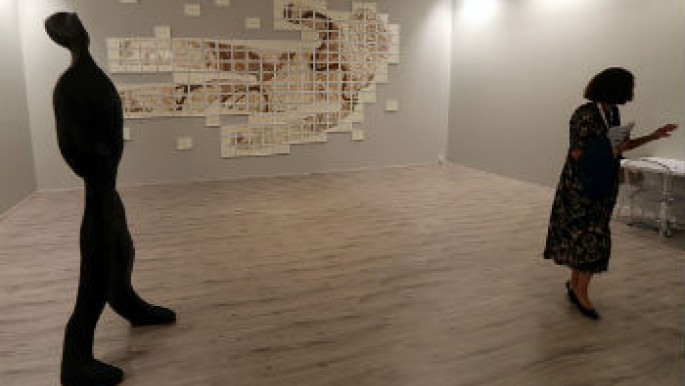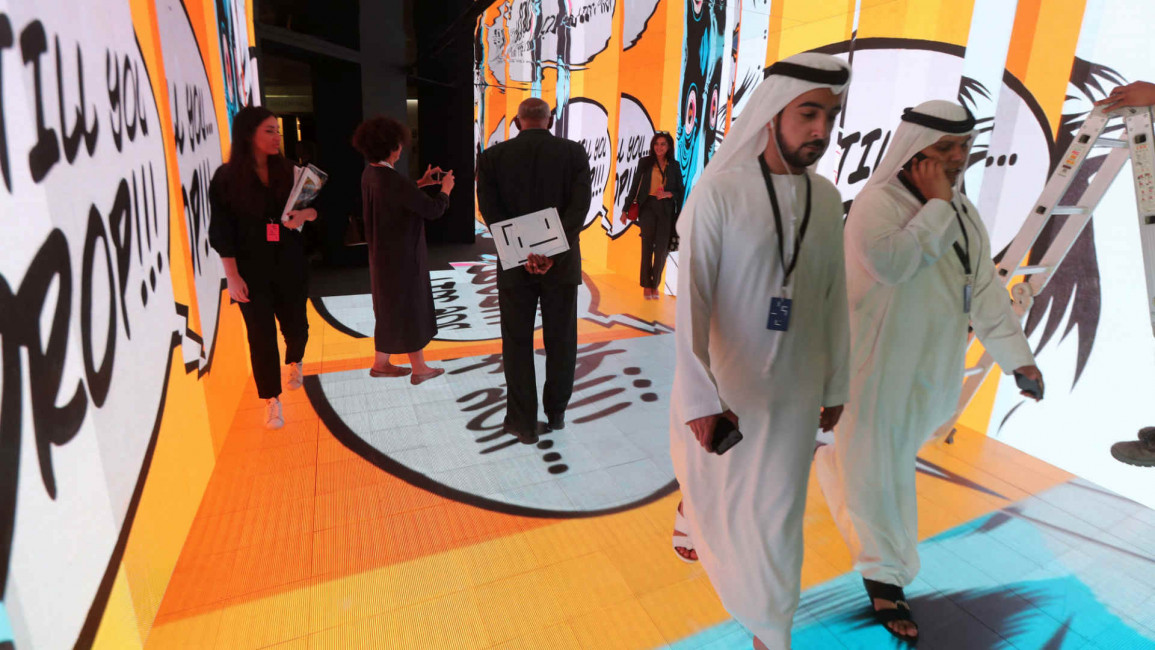
Manufacturing soul: Dubai's emerging cultural capital
Is Dubai, long known for its larger than life commercial excess and international business scene, finally becoming a cultural hub?
While it's hard to manufacture soul, and the words "bohemian" and "Dubai" would seem an incongruous pairing, a dizzying array of cultural facilities, festivals and fairs are currently rivaling the city's vertigo-inducing towers.
And amid regional turmoil and global tendencies towards borders and fences of all kinds, Dubai is arguably emerging as a cross-cultural beacon.
While the current cultural critical mass is a result of the maturation of many projects that began a decade ago, the fruits of Dubai's artistic labours are currently ripe for the picking. And although partly inspired by a rivalry with neighbouring Abu Dhabi's successful rebranding as an arts hub, and undeniably as an international cultural tourism confluence of arts and commerce, it's hard not to be impressed by current happenings.
With this month's Emirates literary festival bringing together global literati, the opening of the new Etihad museum designed by Canadian firm Moriyama and Teshima and the new Janus Rostock-designed opera house - and even a new Quincy Jones-endorsed jazz bar at the luxurious Palazzo Versace, all signs point to a burgeoning cultural renaissance here.
This week's Art Dubai fair, held under the patronage of HH Sheikh Mohammed bin Rashid Al-Maktoum, vice-president and prime minister of the UAE and ruler of Dubai, situates the Gulf metropolis firmly within a global, not merely a regional, cultural context.
Now into its second decade and 11th year, the fair has a new director, Myrna Ayad, and international director, Pablo del Val, at the helm. On until March 18, Art Dubai features 93 galleries, with 500 artists representing 66 different nationalities and 43 countries, with Algeria, Peru and Uruguay represented for the first time this year.
 |
A cornucopia of aesthetic delights, Art Dubai recalls a giant cultural souq, and attending everything - not to mention the colourful nightly after-parties - requires a superhuman energy |  |
Art Dubai is part of the larger regional Art Week, spanning special exhibitons at the Museum of Islamic Art in Qatar to the 13th edition of the Sharjah Biennial - and featuring cultural activities in galleries, institutions and public spaces in Abu Dhabi, Doha, Dubai and Sharjah. These include the sixth edition of Dubai Design Days, on until March 17.
The city is alive with visual and performance art, and this year, Art Dubai Contemporary features 79 galleries spread across its two gallery halls, including a selection of more than 30 galleries focusing on solo or two-artist exhibitions.
A cornucopia of aesthetic delights, Art Dubai recalls a giant cultural souq, and attending everything - not to mention the colourful nightly after-parties - requires a superhuman energy.
Fittingly for its spectacle ambiance, Art Dubai commissions this year focused exclusively on performance art. A series of five specially commissioned performances, curated by guest curator Yasmina Reggad, are presented by international artists Manuel Pelmus, Lana Fahmi, Egle Budvytyte, Iván Argote and Pauline Bastard.
 |
|
| Iraqi artist Sadik Kwaish is one of dozens exhibiting at the largest contemporary art show in the Middle East and North Africa [AFP] |
An homage to recently deceased and internationally celebrated Emirati artist Hassan Sharif, featuring his seven-metre sculpture Cotton Rope (commissioned by Art Dubai in September 2016), will be augmented by an interactive dance performance - in collaboration with choreographer Lana Fahmi - that engages with the work.
Other highlights this year include Cooking Liberty, a surrealist and gastronomic experience presented by Beirut-based art collective Atfal Ahdath, inspired by Salvador Dali’s cookbook, Les Diners de Gala, and Ghariba/Stranger’, a commission by Moroccan-born, Brooklyn-based artist Meriem Bennani that combines an interactive pop-up bar with video portraits of Moroccan women and explores social interaction among strangers.
And while the inherent contradictions for artists living in a globalised, gentrified and expensive city - issues faced by art makers from Vancouver to London to Tokyo and beyond - are obvious, and have been explored by the likes of film-maker Katy Chang in her 2011 film, Glitter Dust: Finding Art in Dubai, and artists like Abbas Akhavan, they are not ignored by the fair.
In spite of its glitz and glamour, it has a reputation for exposing aesthetically and politically cutting edge work.
The careers of artists such as Pakistani Waqas Khan, whose work blends Sufi-inspired imagery with contemporary art and the Lebanese Alfred Tarazi, whose photomontage work details stylized violence and brutal realities of his country's civil war, have been launched here.
 |
Amid the gleaming glass spires of Dubai, it's hard not to feel the ghosts of old cultural capitals like Baghdad and Damascus, whose artists are finding new markets and a new popularity in the face of ongoing regional tribulations |  |
The winner of this year's Abraaj Group Art Prize, for emerging artists from the Middle East, North Africa and South Asia, is London-based Bangladeshi artist Rana Begum - and her work will be unveiled along with shortlisted artists Doa Aly, Sarah Abu Abdallah and Raha Raissnia.
Amid the gleaming glass spires of Dubai, it's hard not to feel the ghosts of old cultural capitals like Baghdad and Damascus, whose artists are finding new markets and a new popularity in the face of ongoing regional tribulations.
London-based Iraqi artist Dia Azaawi makes an appearance this year, via the Meem Gallery, with his 2014 Villager’s Dress channelling a kind of mid-century nostalgic optimism. And a worthwhile trip to Shorja's Maraya Arts Centre reveals Iraqi artist Sadik Kwaish Alfraji's poignant solo exhibition Once Upon a Time: hadiqat al umma, a multi-media installation based on his childhood memories of a favourite Baghdad park.
A talk on March 18 with Henry Kim, director of the Aga Khan Museum in Toronto, and Syrian artist Elias Zayat will examine "the inspiration, symbolism and mythology behind his iconic work, Deluge: The Gods Abandon Palmyra, and the impact of the Syrian crisis on him and fellow artists".
As part of Art Week, Alserkal Avenue and the Atassi Foundation have come together to host Syria: Into the Light, curated by Mouna Atassi, the founder of the Atassi Foundation, in collaboration with writer and curator Rasha Salti.
With the theme of "Portraits and Figures", the show includes more than 60 works by more than 40 artists, exploring the landscape of Syrian art from 1924 to today, representing different movements, techniques and mediums, including painting, drawing, sculpture, photography and video art.
Many of the works are being shown in the MENA region for the very first time.
As if there weren't enough going on, Alserkal Avenue - both the city's arts and culture neighbourhood and an arts organisation in its own right - initiated in 2007 by patron Abdelmonem Bin Eisa Alserkal, is launching the exhibition in a brand new gallery/event space named Concrete, designed by architect Rem Koolhaas.
Where to go for a little respite from the madding art crowds? How about one in a series of talks organised with the support of Alserkal Avenue, called the Art Dubai Modern Symposium.
A panel on March 17 named Modernists and Spirituality features presentations by SH Raza, Anwar Jalal Shemza and Hadi Hazavei, and panelists including Venetia Porter from the British Museum, will look at the influence of spirituality in modern art from the MENA.
What better place to contemplate Dubai's emerging soul confronting its erstwhile soullessness and the future of culture in the region?
Follow Hadani Ditmars on Twitter: @HadaniDitmars


![President Pezeshkian has denounced Israel's attacks on Lebanon [Getty]](/sites/default/files/styles/image_684x385/public/2173482924.jpeg?h=a5f2f23a&itok=q3evVtko)



 Follow the Middle East's top stories in English at The New Arab on Google News
Follow the Middle East's top stories in English at The New Arab on Google News


